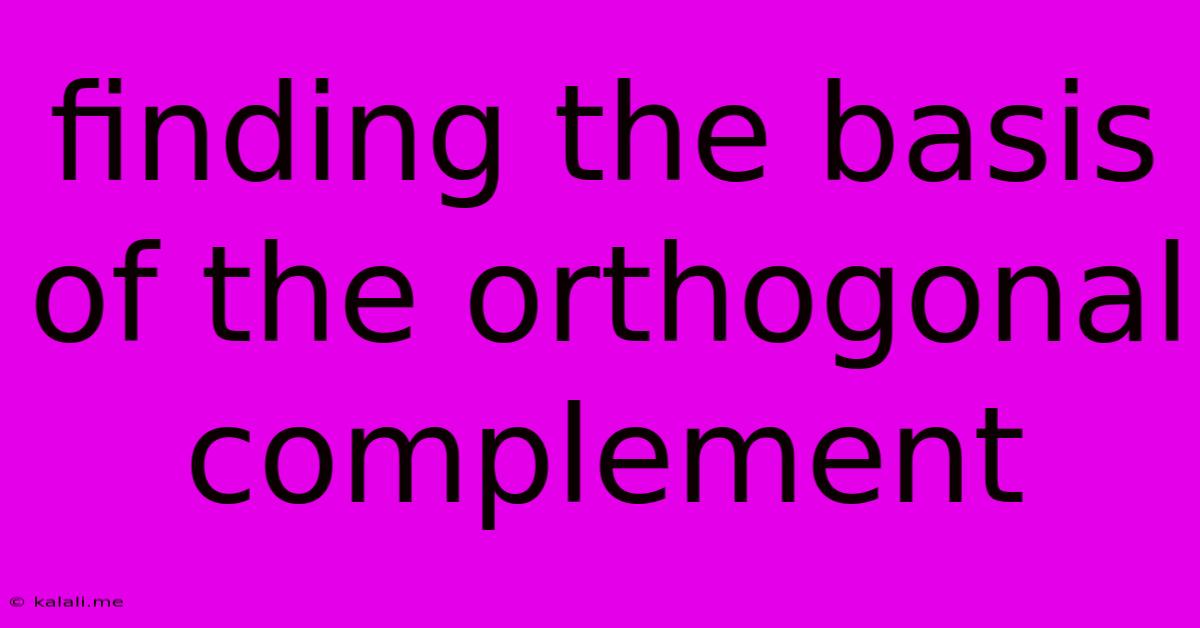Finding The Basis Of The Orthogonal Complement
Kalali
May 23, 2025 · 3 min read

Table of Contents
Finding the Basis of the Orthogonal Complement
Finding the basis of the orthogonal complement of a subspace is a fundamental concept in linear algebra with applications in various fields, including computer graphics, machine learning, and signal processing. This article will guide you through the process, explaining the underlying theory and providing practical examples. Understanding orthogonal complements helps in solving problems related to projection, least squares approximation, and solving systems of linear equations.
What is an Orthogonal Complement?
The orthogonal complement of a subspace W within a vector space V, denoted as W<sup>⊥</sup> (pronounced "W perp"), is the set of all vectors in V that are orthogonal (perpendicular) to every vector in W. In simpler terms, if you have a subspace, its orthogonal complement contains all the vectors that are perpendicular to every vector within that subspace.
Finding the Basis: The Steps
The method for finding the basis of the orthogonal complement involves using the concept of the null space (or kernel) of a matrix. Here's a step-by-step guide:
-
Represent the Subspace as a Matrix: If your subspace W is defined by a set of linearly independent vectors, arrange these vectors as the columns of a matrix A. Each column represents a vector in W.
-
Find the Row Space: The row space of matrix A is the span of its row vectors. It's important to note that the row space of A is not the orthogonal complement.
-
Find the Null Space (Kernel) of the Matrix: The null space of A, denoted as Nul(A), consists of all vectors x such that A**x = 0. Finding the null space typically involves solving a system of homogeneous linear equations. This can be done through techniques like Gaussian elimination or row reduction.
-
The Null Space is the Orthogonal Complement: Crucially, the null space of the matrix A is the orthogonal complement of the column space of A. Therefore, the basis for the null space of A is also the basis for W<sup>⊥</sup>.
Example:
Let's say we have a subspace W in ℝ³ spanned by the vectors v₁ = (1, 0, 1) and v₂ = (0, 1, 0). Let's find the basis of its orthogonal complement W<sup>⊥</sup>.
-
Matrix Representation: We create a matrix A with v₁ and v₂ as columns:
A = | 1 0 | | 0 1 | | 1 0 | -
Find the Null Space: We need to solve A**x = 0:
| 1 0 | | x₁ | | 0 | | 0 1 | | x₂ | = | 0 | | 1 0 | | x₃ | | 0 |This leads to the system of equations:
- x₁ + x₃ = 0
- x₂ = 0
Solving this system gives us x₁ = -x₃ and x₂ = 0. We can express the solution as a vector:
x = x₃(-1, 0, 1)
-
Basis of the Orthogonal Complement: The vector (-1, 0, 1) forms a basis for the null space of A, and therefore, it also forms a basis for W<sup>⊥</sup>. This means any vector orthogonal to both v₁ and v₂ is a scalar multiple of (-1, 0, 1).
Important Considerations:
- Linear Independence: Ensure that the vectors used to define your subspace are linearly independent. If they are not, you'll need to find a linearly independent subset before proceeding.
- Dimensionality: The dimensions of W and W<sup>⊥</sup> are related by dim(W) + dim(W<sup>⊥</sup>) = dim(V), where V is the vector space.
By following these steps, you can systematically find the basis of the orthogonal complement of any given subspace. This understanding is crucial for tackling more complex problems in linear algebra and related fields. Remember to always double-check your calculations to ensure accuracy.
Latest Posts
Latest Posts
-
What Is 20 Percent Of 800 000
Jul 12, 2025
-
Words That Start With Y In Science
Jul 12, 2025
-
Prevent An Expressway Emergency By Merging Without
Jul 12, 2025
-
How Many Grams Of Sugar In A Pound
Jul 12, 2025
-
7am To 11am Is How Many Hours
Jul 12, 2025
Related Post
Thank you for visiting our website which covers about Finding The Basis Of The Orthogonal Complement . We hope the information provided has been useful to you. Feel free to contact us if you have any questions or need further assistance. See you next time and don't miss to bookmark.